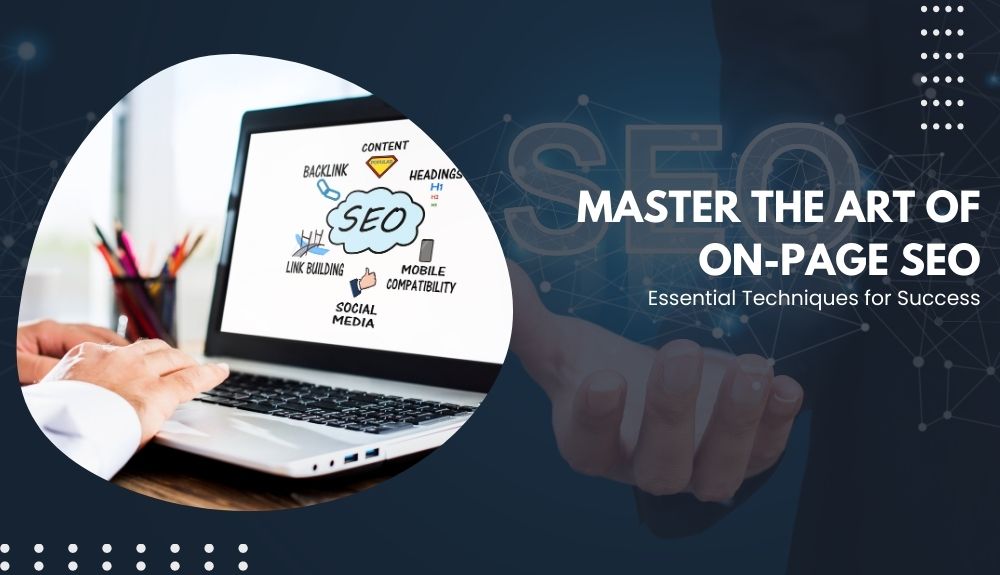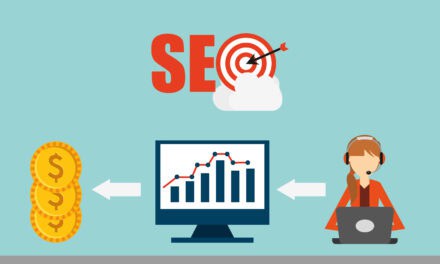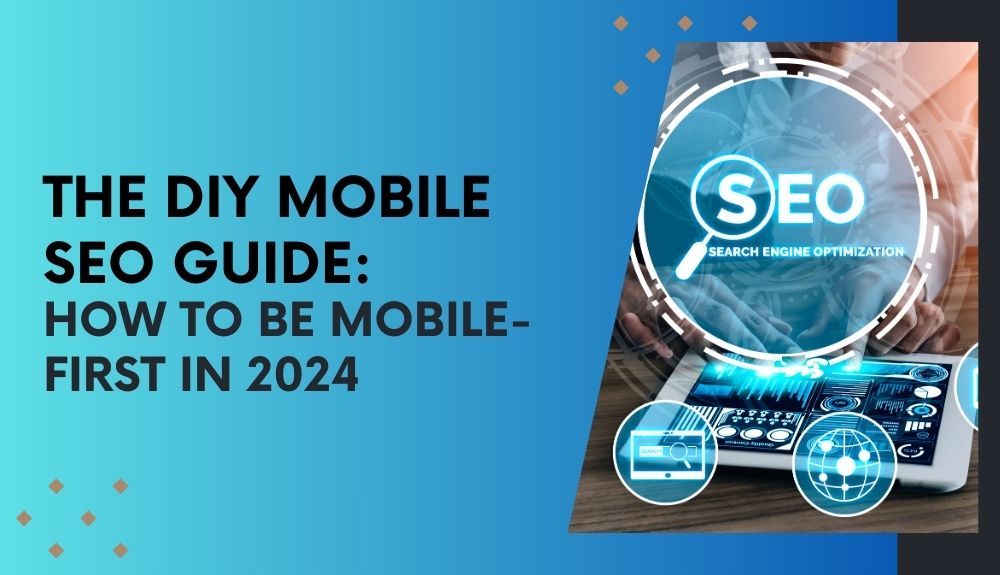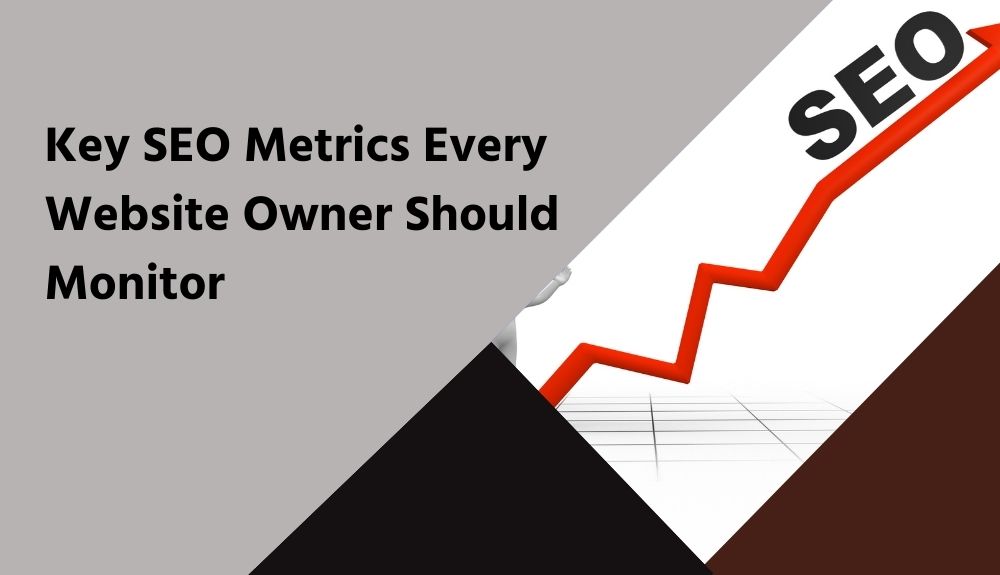Are you struggling to improve your website’s search engine rankings and drive more organic traffic? Look no further. Mastering the art of on-page SEO is the key to success in the digital landscape. With the right techniques, you can optimize your web pages, boost visibility, and achieve higher search engine rankings.
But what exactly is on-page SEO, and why is it so important?
In this blog, we’ll dive deep into the essential techniques that will take your website to the next level. We’ll explore everything from keyword research to meta descriptions and internal linking. You’ll learn how to create high-quality content that satisfies both users and search engines. By following our expert advice and best practices, you’ll be well-equipped to optimize your website and attract more organic traffic.
Ready to unlock the secrets of on-page SEO? Let’s get started on your journey to digital success.
Introduction to On-Page SEO
In today’s highly competitive digital landscape, having a well-optimized website is crucial for success. And when it comes to optimizing your website for search engines, on-page SEO plays a vital role.
On-page SEO refers to the practices and techniques that you implement directly on your website to improve its visibility and search engine rankings. It involves various factors including keyword research, content optimization, meta tags, URL structure, internal linking, mobile responsiveness, and page speed optimization. By optimizing these elements, you can enhance your website’s relevance, credibility, and user experience, which ultimately leads to higher organic search rankings.
Effective on-page SEO not only helps search engines understand the content and purpose of your web pages but also ensures that your website meets the needs of your target audience. It involves providing accurate, informative, and valuable content that is backed by proper research and authoritative references.
Implementing on-page SEO techniques not only benefits your search engine rankings but also improves the overall user experience of your website. By optimizing your web pages, you make it easier for visitors to navigate, access relevant information, and engage with your content.
In the following sections, we will dive deeper into the essential on-page SEO factors and techniques that you need to master in order to boost your website’s visibility and organic traffic. So let’s get started and unlock the full potential of on-page SEO!
Key Takeaways:
– On-page SEO techniques directly impact your website’s visibility and search engine rankings.
– It involves optimizing various elements such as keywords, content, meta tags, URL structure, internal linking, and page speed.
– Effective on-page SEO enhances your website’s relevance, credibility, and user experience.
– It helps search engines understand your content and meets the needs of your target audience.
– By implementing on-page SEO, you can improve your website’s visibility and organic traffic.
Understanding the Essential On-Page SEO Factors
On-page SEO is a crucial component of any successful search engine optimization strategy. By optimizing specific factors within your web pages, you can improve your website’s visibility, search engine rankings, and ultimately drive more organic traffic. Let’s dive into the key on-page SEO factors that you should focus on:
Keyword Research
Keyword research is the foundation of on-page SEO. By identifying the right keywords, you can understand what your target audience is searching for and optimize your content accordingly. Use keyword research tools to find relevant keywords with decent search volume and low competition. Incorporate these keywords strategically throughout your content, including in headings, body text, and meta tags.
Content Optimization
High-quality and well-optimized content is essential for on-page SEO success. Create valuable and informative content that answers your audience’s questions and provides solutions to their problems. Use your target keywords naturally throughout your content, ensuring a good keyword density without keyword stuffing. Remember, the content should be engaging, readable, and valuable to both users and search engines.
Meta Tags Optimization
Meta tags, including title tags and meta descriptions, play a critical role in on-page SEO. The title tag appears as the clickable headline in search engine results, while the meta description provides a brief summary of the web page. Optimize these tags by including relevant keywords and compelling calls-to-action to encourage users to click. Keep the title tag within 60 characters and the meta description within 160 characters.
URL Structure Optimization
An optimized URL structure contributes to better user experience and search engine visibility. Keep your URLs short, descriptive, and keyword-rich. Avoid using unnecessary characters or numbers and separate words with hyphens for improved readability. For example, instead of “www.example.com/page1.php?id=123,” use “www.example.com/keyword-rich-page.”
By focusing on these key on-page SEO factors – keyword research, content optimization, meta tags, and URL structure – you can lay a solid foundation for improving your website’s performance in search engine rankings. Remember to conduct regular audits and make updates as needed to stay ahead of the ever-changing SEO landscape. Implementing these strategies will help your website attract more organic traffic and achieve better visibility in search engine results.
Keyword Research
Keyword research is a crucial step in any on-page SEO strategy as it helps you understand what your target audience is searching for. By identifying the right keywords, you can optimize your web pages to align with user intent, increasing your chances of ranking higher in search engine results.
When conducting keyword research, consider the relevance, search volume, and competition of each keyword. By targeting keywords that are highly relevant to your content and have a decent search volume, you can attract more qualified traffic to your website.
Moreover, keyword research enables you to understand the language and terminology your audience uses when searching for information related to your industry or niche. This knowledge allows you to tailor your content to their needs, providing valuable and targeted information that addresses their queries.
To perform effective keyword research, you can use tools like Google Keyword Planner, SEMrush, or Ahrefs. These tools provide valuable insights into search volume, competition, and related keywords, helping you make informed decisions about the keywords you should target.
Remember, keyword research is an ongoing process. As search trends evolve and user behavior changes, it’s important to regularly review and update your keyword strategy to stay relevant and maintain your competitive edge.
Using the right keywords throughout your content, including in headlines, subheadings, meta tags, and body text, will signal to search engines the relevance of your web pages to specific search queries. However, it’s important to strike a balance and avoid keyword stuffing, as this can negatively impact your search engine rankings.
In conclusion, thorough keyword research is a fundamental aspect of on-page SEO. It empowers you to target the right audience, optimize your content for user intent, and improve your website’s visibility in search engine results. By consistently refining and updating your keyword strategy, you can stay ahead of the competition and drive organic traffic to your website.
Content Optimization
When it comes to on-page SEO, content optimization plays a crucial role in improving your website’s visibility and search engine rankings. By optimizing your web page content, you can ensure that it is both relevant to your target audience and easily understood by search engine crawlers. Here are some tips to help you optimize your content effectively:
1. Keyword Research: Before creating content, conduct thorough keyword research to identify relevant keywords and phrases that your target audience is searching for. Incorporate these keywords naturally throughout your content to improve its relevance and visibility in search results.
2. Valuable Information: Provide valuable and informative content that meets the needs and expectations of your audience. Focus on delivering high-quality, well-researched, and engaging information that addresses their queries and concerns.
3. Heading Tags: Use appropriate heading tags (H1, H2, H3) to structure your content. Heading tags not only break up your content visually but also help search engines understand the hierarchy and relevance of different sections on your page.
4. Meta Descriptions: Write compelling meta descriptions that accurately summarize the content of your page. Well-crafted meta descriptions can improve click-through rates from search engine result pages (SERPs) and provide a concise preview of what users can expect.
5. Internal Linking: Include relevant internal links within your content to guide users to related pages on your website. Internal linking improves website navigation and helps search engine crawlers discover and index your pages more effectively.
6. Readable and Engaging: Use clear and concise language that is easy for your audience to understand. Keep paragraphs short, utilize bullet points and numbered lists, and break up your content with subheadings to enhance readability.
Remember, content optimization is not just about search engines but also about providing value to your audience. By striking a balance between optimized content and user experience, you can create engaging pages that rank well in search results and provide value to your visitors.
For more detailed insights on content optimization and other essential on-page SEO techniques, continue reading our comprehensive guide.
Meta Tags Optimization
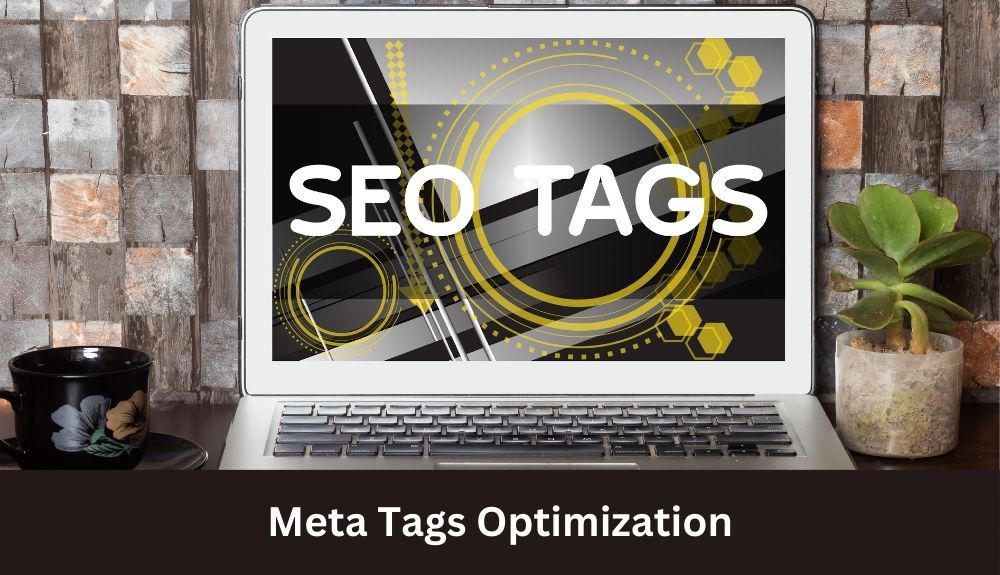
Meta tags play a crucial role in optimizing your web pages for better search engine visibility. By optimizing meta tags such as title tags and meta descriptions, you can improve the chances of your website appearing prominently in search engine results.
Title Tags
Title tags are the HTML elements that define the title of a web page. They appear as clickable headlines in search engine results. Optimizing title tags is essential as they provide both search engines and users with a concise and accurate description of the content on your page.
When optimizing title tags, make sure to include relevant keywords that accurately represent the content of your page. Keep them concise, usually between 50 to 60 characters, to ensure they appear in their entirety in search results.
Meta Descriptions
Meta descriptions are HTML attributes that provide a brief summary of the content on a web page. Although they don’t directly impact search rankings, they influence click-through rates. Well-written meta descriptions can entice users to click on your link, increasing the chances of engagement and traffic.
When crafting meta descriptions, aim to provide a compelling summary of your page’s content while incorporating relevant keywords. Keep them concise, typically between 150 to 160 characters, to ensure they appear in full within search results.
Best Practices for Meta Tags Optimization
To optimize your meta tags effectively, consider the following best practices:
– Ensure each web page has a unique and descriptive title tag.
– Include primary keywords near the beginning of your title tags.
– Write compelling meta descriptions that entice users to click on your link.
– Use action-oriented language and a clear call-to-action in your meta descriptions.
– Make sure your meta tags accurately represent the content of your web pages.
By following these meta tags optimization techniques, you can enhance your website’s search engine visibility and drive more organic traffic to your web pages. Remember, meta tags are an essential element of on-page SEO and should not be overlooked when optimizing your website for search engines.
URL Structure Optimization
The structure of a URL plays a crucial role in both user experience and search engine optimization. Optimizing your URL structure can improve website navigation and make it easier for search engines to understand the content of your pages. Here are some key considerations for URL structure optimization:
1. Keep it concise: Aim for short and descriptive URLs that accurately reflect the content of the page.
2. Use keywords: Incorporate relevant keywords in your URLs to signal search engines about the topic of your page.
3. Avoid unnecessary parameters: Remove any unnecessary parameters or session IDs that can clutter your URLs and make them less user-friendly.
4. Use hyphens as separators: Use hyphens (-) instead of underscores (_) to separate words in your URLs, as it is more readable for both users and search engines.
By optimizing your URL structure, you can enhance the overall usability and search engine visibility of your website.
Internal Linking
Internal linking is a crucial on-page SEO technique that involves linking to other pages within your website. It not only improves website navigation but also helps search engines crawl and index your website more effectively. By strategically placing internal links throughout your content, you can guide users to relevant pages and establish a strong internal website structure. Here are some key tips to optimize your internal linking strategy:
1. Use Descriptive Anchor Text
Choose anchor text that accurately describes the destination page. Instead of using generic phrases like “click here,” use keywords or relevant phrases that provide context for both users and search engines.
2. Link to Relevant Pages
When inserting internal links, ensure that the destination page is relevant to the current content. Link to pages that provide additional information or expand on the topic at hand, enhancing the user experience and encouraging further exploration of your website.
3. Maintain a Logical Link Hierarchy
Organize your internal links in a logical hierarchy. This means linking from high-level pages (such as the homepage or category pages) to more specific sub-pages. This structure helps search engines understand the importance and relationships between different pages on your website.
4. Avoid Excessive Internal Linking
While internal linking is essential, avoid overdoing it. Too many internal links can confuse users and dilute the value of each link. Focus on quality over quantity, ensuring that every internal link adds value and enhances the user’s journey.
5. Update Broken or Outdated Links
Regularly check your website for broken or outdated internal links. Broken links can negatively impact user experience and hinder search engine crawling. Use tools like Google Search Console to identify and fix any broken links promptly.
6. Leverage Footer and Sidebar Links
Include relevant internal links in your website’s footer and sidebar sections. These sections appear on multiple pages and provide additional opportunities to guide users to important pages or resources.
7. Monitor and Analyze Internal Link Performance
Track the performance of your internal links using tools like Google Analytics. Analyze user behavior to identify which internal links are driving the most engagement and traffic. Use this data to refine your internal linking strategy and optimize your website’s overall performance.
By implementing these internal linking best practices, you can improve the navigational structure of your website, enhance user experience, and boost your search engine rankings.
Mobile Responsiveness
In today’s digital age, having a mobile-friendly website is no longer an option but a necessity. With the increasing use of mobile devices for internet browsing, search engines prioritize mobile responsiveness in their rankings. The user experience plays a crucial role in determining search engine visibility.
A mobile-friendly website ensures that your content is easily accessible and readable on devices of all sizes. It eliminates the frustration of users having to zoom in or scroll horizontally to view the content properly. A responsive design adapts seamlessly to different screen sizes, maintaining the integrity of your website’s layout and functionality.
Moreover, mobile responsiveness also impacts website loading speed. A website optimized for mobile devices tends to load faster, enhancing the user experience. Page speed is a significant ranking factor, and a slow-loading website can deter both users and search engines.
To achieve mobile responsiveness, consider using a responsive website design that automatically adjusts to fit different screen sizes. Optimize images and use compressed files to ensure quick loading on mobile devices. Regularly test your website’s mobile-friendliness and make necessary adjustments to enhance the user experience and improve search engine rankings.
By prioritizing mobile responsiveness, you not only cater to your mobile audience but also meet the expectations of search engines, which ultimately boosts your website’s visibility.
Page Speed Optimization
Page speed is a crucial factor in on-page SEO that significantly impacts both user experience and search engine rankings. Optimizing your website’s speed can improve the overall user satisfaction, reduce bounce rates, and increase conversion rates. Additionally, search engines like Google prioritize websites with fast loading times, considering it an essential ranking factor.
To optimize your page speed, consider the following tips:
1. Minimize server response time: Ensure that your web hosting server is efficient and responds quickly to user requests.
2. Optimize images: Compress and optimize images to reduce their file size without sacrificing quality. Use formats like JPEG or WebP and leverage lazy loading techniques.
3. Enable browser caching: Implement browser caching to store temporary files on users’ devices, reducing the need to reload the entire webpage on subsequent visits.
4. Reduce HTTP requests: Minimize the number of HTTP requests by combining and minimizing CSS and JavaScript files. This reduces the load time of your webpage.
5. Enable compression: Enable Gzip compression on your server to reduce the size of web page files sent to users’ browsers.
6. Minify CSS and JavaScript: Remove unnecessary characters and spaces from your CSS and JavaScript files to reduce their file size.
By implementing these page speed optimization techniques, you can create a faster, more efficient website that provides an exceptional user experience and improves your search engine rankings. Remember, a fast-loading website has the potential to attract more visitors, increase engagement, and drive organic traffic.
On-Page SEO Checklist
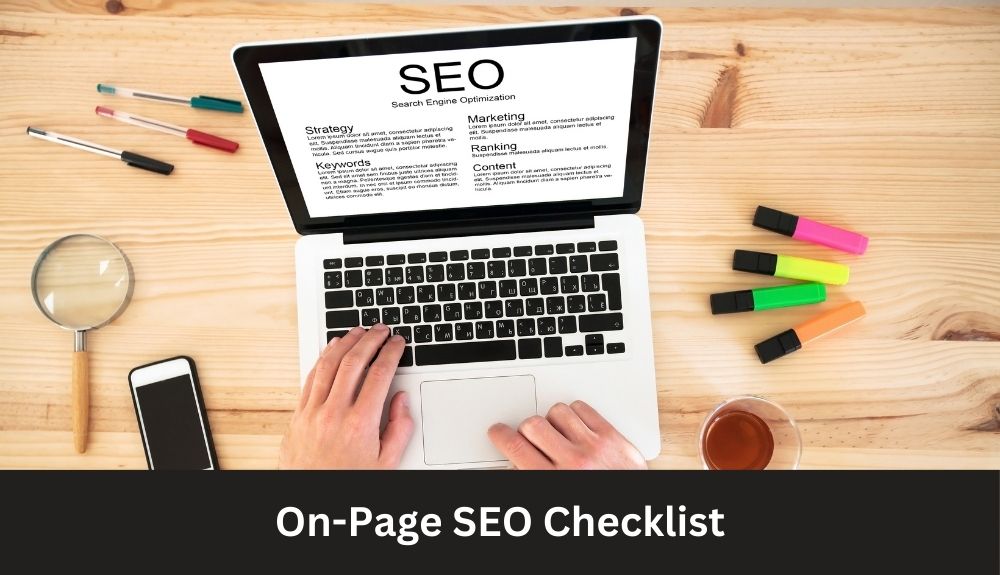
Ensuring that your website is optimized for on-page SEO is crucial to improve its visibility and search engine rankings. By implementing the following checklist of essential on-page SEO techniques, you can enhance your website’s performance and attract organic traffic.
1. Keyword Usage
– Conduct thorough keyword research to identify relevant and high-ranking keywords.
– Strategically incorporate target keywords into your content, headings, and meta tags.
– Avoid keyword stuffing and maintain a natural flow of your content.
2. Meta Tags Optimization
– Optimize your page titles (title tags) by including relevant keywords and keeping them within the recommended length of 50-60 characters.
– Craft compelling and click-worthy meta descriptions that accurately summarize the content of your web page. Aim for a length of around 150-160 characters.
3. Content Formatting
– Create well-structured content with clear headings (H1, H2, H3) and subheadings to guide readers and search engines.
– Use bullet points and numbered lists to organize information and improve readability.
– Include relevant images, alt tags, and descriptive captions to enhance engagement.
4. URL Optimization
– Optimize your URL structure by keeping it concise, descriptive, and keyword-rich.
– Minimize the use of unnecessary parameters or symbols in your URLs.
– Use hyphens to separate words in your URLs for better readability.
5. Internal Linking
– Incorporate internal links within your content to improve website navigation and establish a logical hierarchy.
– Link relevant pages using anchor text that includes descriptive keywords.
– Ensure all internal links are functional and lead to useful and relevant content.
6. Mobile Responsiveness
– Ensure your website is mobile-friendly and provides a seamless user experience across different devices.
– Use responsive design techniques to automatically adapt your website’s layout to fit different screen sizes.
– Optimize loading speed and minimize the use of large file sizes or unnecessary elements.
Remember, implementing these on-page SEO techniques is just the first step towards achieving better search engine rankings and visibility. Regularly monitor your website’s performance, stay updated with industry trends, and adapt your on-page SEO strategies accordingly.
By following this checklist, you can optimize your website’s on-page SEO elements and increase your chances of ranking higher in search engine results.
Conclusion: Implementing On-Page SEO Techniques
Implementing on-page SEO techniques is crucial for improving your website’s visibility and search engine rankings. By optimizing various elements on your web pages, you can enhance the overall user experience and attract more organic traffic. Here are some key takeaways to keep in mind:
1. Boost Search Visibility: On-page SEO helps search engines understand the content and context of your web pages, improving their chances of ranking higher in search results. By optimizing your title tags, meta descriptions, and headers with relevant keywords, you can increase the likelihood of appearing on the first page of search results.
2. Improve User Experience: On-page SEO involves optimizing your website’s structure, navigation, and load speed. A well-structured website with user-friendly navigation enhances the overall user experience, leading to longer visit durations, lower bounce rates, and higher conversion rates.
3. Target the Right Audience: Comprehensive keyword research allows you to target the exact terms and phrases your target audience is searching for. By incorporating these keywords naturally throughout your content, you can attract relevant traffic and increase the chances of conversions.
4. Stay Ahead of the Competition: Implementing best practices for on-page SEO puts you at an advantage over your competitors. By providing high-quality content, optimizing meta tags, and optimizing your URL structure, you increase your chances of outperforming others in your niche.
5. Adapt to Mobile-First Indexing: With the rise of mobile devices, having a mobile-responsive website is essential. Incorporate responsive design techniques to ensure that your site looks and functions seamlessly on any device. This not only improves the user experience but also positively impacts your search engine rankings.
In conclusion, by implementing on-page SEO techniques, you can enhance your website’s visibility, attract targeted traffic, and ultimately achieve better search engine rankings. Stay up to date with the latest trends and best practices to ensure that your on-page SEO efforts continue to drive positive results.
Remember, consistently monitoring your website’s performance and making necessary adjustments based on user feedback and search engine guidelines will help you achieve the best possible outcomes from your on-page SEO efforts.

